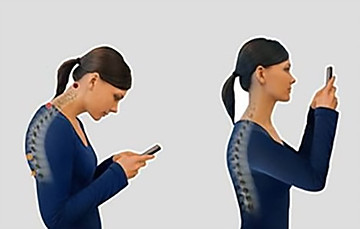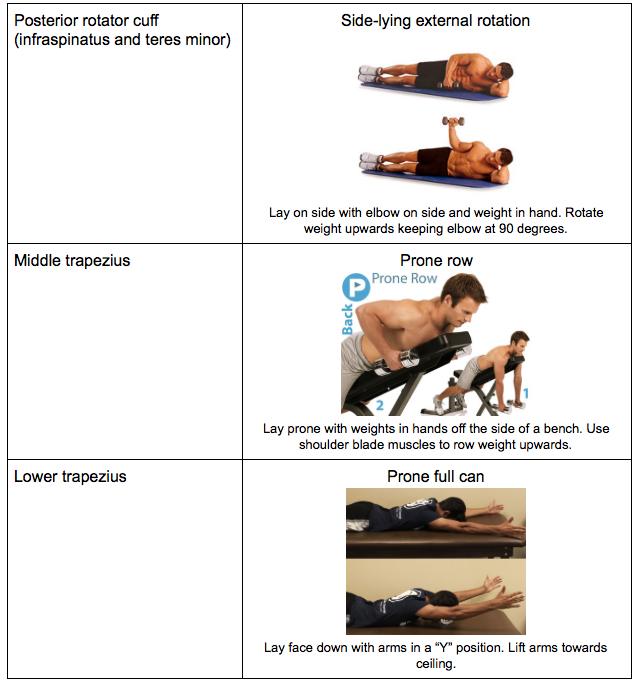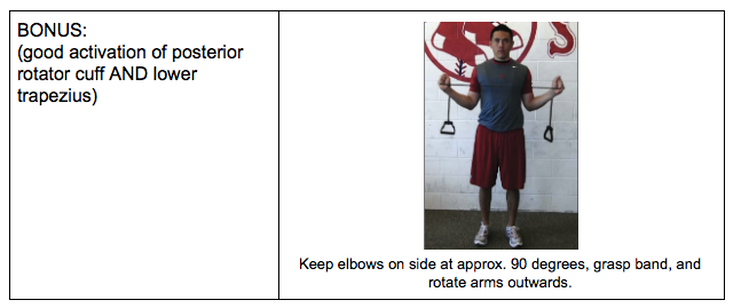As the technological world of laptops, cell phones, and tablets forces us to focus our attention downwards and inwards, many of us begin to feel pain, or stiffness in our necks, upper backs, or shoulders.
Often, we adopt a common cell phone posture (see below), which can increase our risk of neck, back, or shoulder pain.

As you can see in the above picture, our preferred cell phone posture leads to increased neck flexion, increased upper back kyphosis (forward curve), and forward/rounded shoulders.
When this causes pain, it has been dubbed “tech-neck” or “text-neck”.
Alternatively, we could adopt an improved posture, such as the second position in the above photo.
It encourages an upright torso, with a neutral spine and retracted (pulled down and back) shoulder blades.
For some, even obtaining the more upright, improved posture can be difficult. As a physiotherapist, I often hear that it’s too hard for people to keep their torso upright, with their shoulders down and back.
In my opinion, most people feel this way because the upright posture is so different from what they’re used to.
Further, the increased amount of time they spend in the poor posture causes their shoulder and scapula (shoulder blade) muscles to be on a constant stretch.
The constant stretch leads to inhibition of these muscles, and apparent weakness. Therefore, people find it difficult to obtain an improved, upright posture because their muscles don’t have the capacity to maintain that position.
So How Do I Improve My Capacity To Obtain That Position?
Great question.
A good place to start is to simply try and obtain that (improved) position as often as you remember.
Set an alarm on your phone, add a post-it note to your computer, tell others to have you ‘sit up tall’ or ‘stand up tall’ – just be in the improved position more than you are now.
Slowly it will feel less difficult. Secondly, improve your capacity through exercise. This is the fun part!
17 muscles attach to the shoulder blade, cool right!?
Strengthening some of these scapular muscles can lead to improvements in your ability to maintain a good posture, as well as improvements in your pain and stiffness! NOW FOR THE SCIENCE!!! This paper outlines the recommended exercises for each muscle [Aside: to the physiotherapists reading this-go read that paper].
Many of these recommendations are based on electromyographic (EMG) evidence. EMG is how we measure muscle activity.
The higher the EMG measured in a muscle with a certain exercise, the higher the muscle activity with that exercise.
So in theory, the higher the muscle activity, the higher the chances of good strength building!
So What Muscles Should I Build?
Another great question. I would recommend starting with your posterior rotator cuff muscles (infraspinatus and teres minor), the middle trapezius, and the lower trapezius.
These muscles are responsible for drawing your shoulders/shoulder blades down and back and for controlling arm/shoulder movement (especially overhead!).
Improving the activation/strength in these muscles will allow you to obtain the improved posture more easily! Spending more time in the improved posture will help your pain!
Here’s a table of the recommended exercises for activating each of those muscles (from the research paper mentioned above!):


Start by doing 2 sets of 10 repetitions of each exercise 1-2 times a day.
If that’s too hard, do fewer reps. If that’s too easy, do more reps. Find the numbers that make you tired, but not painful!
If anything is painful or too difficult, consult a physiotherapist!
Conclusion
If your cell phone, laptop, or tablet is bringing you down, bring yourself back up! Consciously think about your posture, activate some muscles, and take care of yourself!
Do you suffer from TechNeck? Is obtaining a good posture difficult for you? Want to get out of pain, and back to function?
At Strive Physiotherapy and Performance, we are committed to providing in-depth, one-on-one assessments and treatments to ensure a quick and comfortable recovery.
Call us at 519-895-2020, or use our online booking tool on www.strivept.ca to book an appointment with one of our knowledgeable physiotherapists today!
Take care,
Tyler Allen
Physiotherapist at Strive Physiotherapy and Performance
References:
- Reinold, M. M., Escamilla, R., & Wilk, K. E. (2009). Current concepts in the scientific and clinical rationale behind exercises for glenohumeral and scapulothoracic musculature. journal of orthopaedic & sports physical therapy, 39(2), 105-117.
Exercise Image sources:
- Side-lying External Rotation: https://weightlossandtraining.com/images/Exercises/side-lying-external-rotation.jpg
- Prone Row: http://www.60dayswithnatjones.com/wp-content/uploads/2009/09/BaSt-DB_Prone_Row .jpg
- Prone Full Can: http://www.cbphysicaltherapy.com/wp-content/uploads/2015/04/Prone-Y.jpg
- Bilateral External Rotation: Reinold, M. et al. (2009). Current concepts in the scientific and clinical rationale behind exercises for glenohumeral and scapulothoracic musculature. journal of orthopaedic & sports physical therapy, 39(2), 105-117.